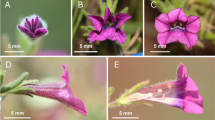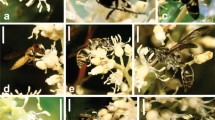Abstract
Plants often combine multiple strategies to achieve pollen transfer. The dioecious Clusia nemorosa (Clusiaceae) produces floral resin, a specialized reward for resin-collecting bees. It also exhibits floral automimicry with female flowers mimicking male flowers in order to attract pollen-collecting insects. We observed the hourly visitation frequency and behaviour of bee visitors on two rock savanna sites in French Guiana. The major strategy in pollen transfer and the variation in visitation rates among visitor species were examined. We hypothesized that the visitation rate will vary between the floral sexes and degree of this variation will differ between the two-reward systems. We found no evidence for visits being exclusively related to resin collection, which we expected to be the principal strategy in pollen transfer. Deceit pollination appeared to have minor importance and seemed to be locally associated with the site, where demand for pollen was greater. Flower visits that probably facilitated most pollen transfer, combined resin and pollen. The pollinators involved in this system collected pollen from male flowers and resin from female flowers. The fruit set was not particularly low (44.19%) so offering different rewards by different flower genders has not constrained reproductive success in this system. Pronounced variation in visitation rates between sexes was not related to the pollination mechanisms but to the demand for the two rewards. Overall demand for pollen was greater than demand for resin. Female flowers were visited much less frequently than male flowers. Peak pollen collection occurred in the morning, i.e., as soon as the resource was available, while resin was collected throughout the day. There was a local variability in demand for the two resources because both the visitation rate and the behaviour of foraging bees varied between the two observation sites.


Similar content being viewed by others
References
Ågren J, Schemske DW (1991) Pollination by deceit in a neotropical monoecious herb, Begonia involucrata. Biotropica 23:235–241
Albuquerque PMC, Camargo JMF (2007) New species of Trigonisca Moure (Hymenoptera, Apidae, Apinae). Rev Bras Ent 51:160–175
Armbruster WS (1984) The role of resin in angiosperm pollination: ecological and chemical considerations. Am J Bot 71:1149–1160
Bawa KS (1980) Evolution of dioecy in flowering plants. Ann Rev Ecol Sys 11:15–39
Bernhardt P, Sage T, Weston P, Azuma H, Lam M, Thien LB, Bruhl J (2003) The pollination of Trimenia moorei (Trimeniaceae): floral volatiles, insect/wind pollen vectors and stigmatic self-incompatibility in a basal angiosperm. Ann Bot 92:445–458
Belbenoit P, Poncy O, Sabatier D, Prévost M, Riéra B, Blanc P, Larpin D, Sarthou C (2001) Floristic checklist of the Nouragues area. In: Bongers F, Charles-Dominique P, Forget P-M, Théry M (eds) Nouragues. Dynamics and plant-animal interactions in a neotropical rainforest. Kluwer Academic Publishers, Dordrecht, pp 65–78
Bittrich V, Amaral MDE (1997) Floral biology of some Clusia species from Central Amazonia. Kew Bull 52:617–635
Brunet J (2009) Pollinators of the Rocky Mountain columbine: temporal variation, functional groups and associations with floral traits. Ann Bot 103:1567–1578
Camargo JMF, Pedro SRM (2007) Meliponini Lepeletier, 1836. In: Moure JS, Urban D, Melo GAR (eds) Catalogue of bees (Hymenoptera, Apoidea) in the Neotropical region. Sociedade Brasileira de Entomologia, Curitiba, Brazil, pp 272–578
Dafni A (1992) Pollination ecology: a practical approach. IRL Press at Oxford University Press, New York
de Oliveira CMA, Porto AM, Bittrich V, Vencato I, Marsaioli AJ (1996) Floral resins of Clusia spp.: chemical composition and biological function. Tetrahedron Lett 37:6427–6430
do Carmo RM, Franceschinelli EV (2002) Polinizaçăo e biologia floral de Clusia arrudae Planchon & Triana (Clusiaceae) na Serra da Calçada, município de Brumadinho, MG. Rev Bras Bot 25:351–360
Duangphakdee O, Koeniger N, Deowanish S, Hepburn HR, Wongsiri S (2009) Ant repellent resins of honeybees and stingless bees. Insect Soc 56:333–339
Dukas R (1987) Foraging behavior of three bee species in a natural mimicry System: female flowers which mimic male flowers in Ecballium elaterium (Cucurbitaceae). Oecologia 74:256–263
Dunthorn M (2004) Cryptic dioecy in Mammea (Clusiaceae). Plant Syst Evol 249:191–196
Eltz T, Bruhl CA, van der Kaars S, Linsenmair KE (2002) Determinants of stingless bee nest density in lowland dipterocarp forests of Sabah, Malaysia. Oecologia 131:27–34
Francis B, Green M, Payne C (1993) GLIM 4: the statistical system for generalized linear interactive modelling. Clarendon Press, Oxford
Giménez-Benavides L, Dötterl S, Jürgens A, Escudero A, Iriondo JM (2007) Generalist diurnal pollination provides greater fitness in a plant with nocturnal pollination syndrome: assessing the effects of a Silene-Hadena interaction. Oikos 116:1461–1472
Grimaldi M, Riéra B (2001) Geography and climate. In: Bongers F, Charles-Dominique P, Forget P-M, Théry M (eds) Nouragues. Dynamics and plant-animal interactions in a neotropical rainforest. Kluwer Academic Publishers, Dordrecht, Boston, London, pp 9–18
Gustafsson MHG, Bittrich V (2002) Evolution of morphological diversity and resin secretion in flowers of Clusia (Clusiaceae): insights from ITS sequence variation. Nord J Bot 22:183–203
Gustafsson MHG, Bittrich V, Stevens PF (2002) Phylogeny of Clusiaceae based on rbcL sequences. Int J Plant Sci 163:1045–1054
Herrera CM (1988) Variation in mutualisms-the spatio-temporal mosaic of a pollinator assemblage. Bot J Linn Soc 35:95–125
Hubbell SP, Johnson LK (1977) Competition and nest spacing in a tropical stingless bee community. Ecology 58:949–963
Hubbell SP, Johnson LK (1978) Comparative foraging behavior of six stingless bee species exploiting a standardized resource. Ecology 59:1123–1136
Johnson LK, Hubbell SP (1975) Contrasting foraging strategies and coexistence of two bee species on a single resource. Ecology 56:1398–1406
Kawagoe T, Suzuki N (2002) Floral sexual dimorphism and flower choice by pollinators in a nectarless monoecious vine Akebia quinata (Lardizabalaceae). Ecol Res 17:295–303
Kawagoe T, Suzuki N (2004) Cryptic dioecy in Actinidia polygama: a test of the pollinator attraction hypothesis. Can J Bot 82:214–218
Leonhardt SD, Blüthgen N (2009) A sticky affair: resin collection by Bornean stingless bees. Biotropica 41:730–736
Lokvam J, Braddock JF (1999) Anti-bacterial function in the sexually dimorphic pollinator rewards of Clusia grandiflora (Clusiaceae). Oecologia 119:534–540
Lopes AV, Machado IC (1998) Floral biology and reproductive ecology of Clusia nemorosa (Clusiaceae) in northeastern Brazil. Plant Syst Evol 213:71–90
Maguire B (1966) Genus Clusia (Guttiferae) in Suriname. Acta Bot Neerl 15:63–75
Marsaioli AJ, Porto AM, Gonçalves RAC, de Oliveira CMA, Manfio GP, Bittrich V (1998) The Ecosystem of microorganisms, bees, and Clusia floral resin and oils, from the chemistry point of view. Pure Appl Chem 70:2116–2123
Martins RL, Wendt T, Margis R, Scarano FR (2007) Reproductive biology. In: Lüttge U (ed) Clusia: a woody neotropical genus of remarkable plasticity and diversity. Springer-Verlag, Berlin, Heidelberg, New York, pp 73–94
Mayer SS, Charlesworth D (1991) Cryptic dioecy in flowering plants. Trends Ecol Evol 6:320–325
Mesquita RCG, Franciscon CH (1995) Flower visitors of Clusia nemorosa G. F. W. Meyer (Clusiaceae) in an Amazonian white-sand campina. Biotropica 27:254–258
Michener CD (1974) The social behavior of the bees: a comparative study. The Belknap Press of Harvard University Press, Cambridge
Michener CD (2007) The bees of the world. The John Hopkins University Press, Baltimore
Nagamitsu T, Inoue T (1997) Aggressive foraging of social bees as a mechanism of floral resource partitioning in an Asian tropical rainforest. Oecologia 110:432–439
Nagamitsu T, Momose K, Inoue T, Roubik DW (1999) Preference in flower visits end partitioning in pollen diets of stingless bees in an Asian tropical rain forest. Res Popul Ecol 41:195–202
Ollerton J (1996) Reconciling ecological processes with phylogenetic patterns: the apparent paradox of plant-pollinator systems. J Ecol 84:767–769
Pipoly JJ, Kearns DM, Berry PE (1998) Clusia. In: Berry PE, Holst BK, Steyermark JA, Yatskievych K (eds) Flora of the Venezuelan Guayana. Vol. 4: Caesalpiniaceae-Ericaceae. Missouri Botanical Garden Press, St. Louis, pp 260–297
Porto ALM, Machado SMF, de Oliveira CMA, Bittrich V, Amaral MdCE, Marsaioli AJ (2000) Polyisoprenylated benzophenones from Clusia floral resins. Phytochemistry 55:755–768
Roubik DW (1989) Ecology and natural history of tropical bees. Cambridge University Press, New York
Roulston TH, Cane JH (2000) Pollen nutritional content and digestibility for animals. Plant Syst Evol 222:187–209
Sarthou C (1992) Dynamique de la végétation pionnière sur un inselberg en Guyane française. Université Paris 6, France
Sarthou C (2001) Plant communities on a granitic outcrop. In: Bongers F, Charles-Dominique P, Forget P-M, Théry M (eds) Nouragues. Dynamics and plant-animal interactions in a neotropical rainforest. Kluwer Academic Publishers, Dordrecht, Boston, London, pp 65–78
Schemske DW, Ågren J (1995) Deceit pollination and selection on female flower size in Begonia involucrata: an experimental approach. Evolution 49:207–214
Schwarz HF (1938) The stingless bees (Meliponidae) of British Guiana and some related forms. Bull Am Mus Nat Hist 74:437–508
Schwarz HF (1948) Stingless bees (Meliponidae) of the western hemisphere. Bull Am Mus Nat Hist 90:1–546
The C. V. Starr Virtual Herbarium (2010) http://sciweb.nybg.org/science2/VirtualHerbarium.asp
van Nieuwstadt MGL, Iraheta CER (1996) Relation between size and foraging range in stingless bees (Apidae, Meliponinae). Apidologie 27:219–228
Vlasáková B (2010) Plant-animal interactions in an inselberg ecosystem: the effect on reproduction of selected species. Department of Botany, Faculty of Sciences. Charles University of Prague, Prague
Waser NM, Chittka L, Price MV, Williams NM, Ollerton J (1996) Generalization in pollination systems, and why it matters. Ecology 77:1043–1060
Willson MF, Ågren J (1989) Differential floral rewards and pollination by deceit in unisexual flowers. Oikos 55:23–29
Acknowledgments
We thank Heiko Hentrich and Holger Teichert for their helpful comments on the manuscript and Frederick Rooks for his advice on English usage. Thanks are also due to Pierre Charles-Dominique and his French colleagues for their hospitality and support during our work. This study was supported by the Fund for Neotropical Plant Research of The New York Botanical Garden, the Grant Agency of the Charles University (152/2005), the Czech Science Foundation (206/03/H137) and by the institutional project AV0Z60050516 (Grant Agency of the Academy of Sciences of the Czech Republic). The experiments conducted in this study comply with the current laws of France and the Czech Republic.
Author information
Authors and Affiliations
Corresponding author
Rights and permissions
About this article
Cite this article
Vlasáková, B., Jarau, S. Dioecious Clusia nemorosa achieves pollination by combining specialized and generalized floral rewards. Plant Ecol 212, 1327–1337 (2011). https://doi.org/10.1007/s11258-011-9908-0
Received:
Accepted:
Published:
Issue Date:
DOI: https://doi.org/10.1007/s11258-011-9908-0




